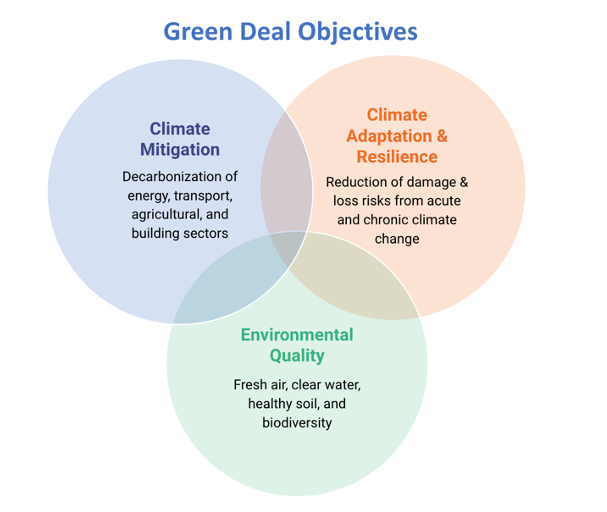 Alpes-de-Haute-Provence. Les Mees. Shutterstock, BTWImages.
Alpes-de-Haute-Provence. Les Mees. Shutterstock, BTWImages.
The Paris Agreement is the main instrument governing the global response to climate change. Article 2.1c calls for making “finance flows consistent with a pathway towards low greenhouse gas emissions and climate-resilient development,” seeking to crowd in public and private financing for green objectives, while crowding out negatively aligned expenditures. Governments can align resources and incentives through their public sector budgets to achieve national development priorities, including climate action. But how can this be verified?

Climate Budgeting Baselines
Austria, France, and the EU’s climate budget experiences demonstrate how governments are integrating climate action into budgets by systematically tracking positive and negative expenditures and taxes.
In Austria, the government is conducting annual reviews to improve both the allocative and operational efficiency of the country's green spending. A baseline spending review of financial flows completed in 2022 revealed that 11.4% of expenditures and 11.5% of revenues were relevant for Austria’s climate, energy, and environmental objectives, as defined by the country’s national green public finance taxonomy. This was right on target with Austria’s National Development Strategy. By the end of 2025, four additional reviews are planned on subnational linkages, EU alignment, public sector actions, and green procurement. Going forward, to help classify the impacts of public financial flows on the climate, energy, and environmental objectives, the government will develop a six-step Green Budgeting Scorecard.
France, a leader in green budgeting, has published two green budget reviews in advance of its 2021 and 2022 budgets. These reviews covered both regular and tax expenditures and used a green budgeting methodology based on the EU taxonomy for sustainable activities to identify and rate the impact of expenditures on six environmental objectives:
- Climate change mitigation
- Climate change adaptation
- Water management
- Waste management (transition to a circular economy)
- Pollution management
- Biodiversity conservation
The impact of budget expenditures is rated as favorable (scores +3 to +1), neutral (score 0), and unfavorable. The reviews revealed that while 6.5% of the covered consolidated regular and tax expenditures (€495.1 billion) under the 2022 budget had a favorable impact, 0.9%had mixed impact, and 2.2% generated unfavorable impact. In the case of tax expenditures, those with unfavorable impact were more than double than those with favorable impact (€7.6 billion versus €3.4 billion).
The EU’s experience shows that how spending programs are assessed is open to scrutiny. In its previous 2014-2020 program, the EU had targeted for its green expenditures to reach 20%, while in 2021-2027, it plans to allocate 30% to green expenditures. However, a review by the European Court of Auditors revealed that only 13% could be considered as green expenditures. The audit results also questioned the new program's methodologies and taxonomies with respect to what can be considered green as well as validation. Yet, such discrepancies notwithstanding, green budgeting and auditing should be considered as a natural process by which the credibility of the budgeting efforts can grow over time.
Lessons for Central and Eastern Europe
There is clearly growing awareness of and impetus for designing and implementing green budgeting measures across Central and Eastern Europe with a focus on climate action. The evolving EU and country experiences provide valuable lessons for countries across the region that find themselves at different stages of both climate-action and wider Public Financial Management (PFM) development.
Strategic Demand and Leadership: Country-owned strategies for both mitigation and adaptation are vital for setting the directions of climate action and working to better align key priorities of public and private financing flows. Care must be taken to ensure that development of these strategies is adequately grounded among all key stakeholders. Country drivers for climate action can be both external and internal, and must be reflected in key channels, including the public sector budgets.
Climate-informed budgeting readiness: To determine if public spending is delivering on climate action, as set out in both international and domestic commitments, climate-informed budgeting becomes an important tool. Global experience suggests that some form of Program Based-Budgeting is an important foundation for understanding the objectives of key programs and for evaluating through climate budget tagging if such programs impact climate action. Mainstreaming climate-informed budgeting preparation, tracking, and reporting as part of Integrated Financial Management Systems will help promote sustainability and deliver a more systematic and replicable approach. This means that ministries of finance will also play an increasingly central role in ensuring that green budgeting is effectively mainstreamed, as well as assessing efficiency through a program of targeted spending reviews as gaining application in Austria. The Coalition of Finance Ministers for Climate Action is one network that reflects this recognition.
Climate-informed budgeting for results: The EU experience suggest that Supreme Audit Institutions can play an important role in helping assess if spending is effectively contributing to climate action. Delivering climate action results through public spending and taxation will require a systematic approach. Credible tracking and reporting are key in facilitating transition from awareness to action and will also help to ensure that these efforts are cost effective, which requires further analysis and ongoing engagement with different sector agencies.
Countries such as Georgia are also taking proactive measures to prioritize and sequence green budgeting policies and practices. As more green budgeting experiences emerge from across Europe and Central Asia and the world, they will increasingly provide robust knowledge for stronger peer learning and country ownership.





Join the Conversation